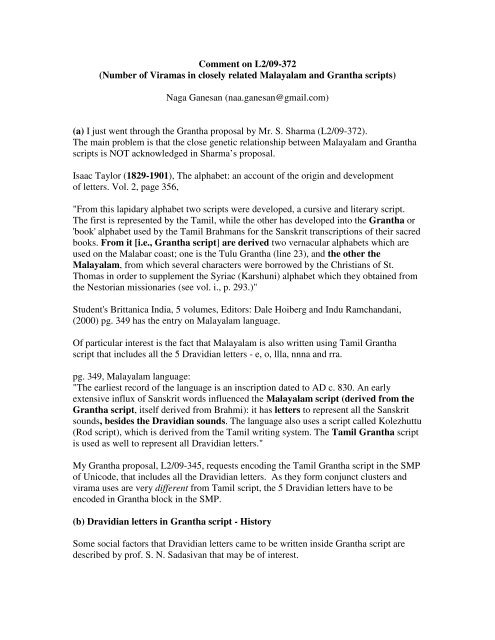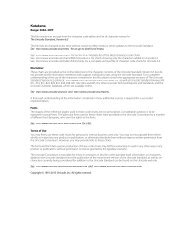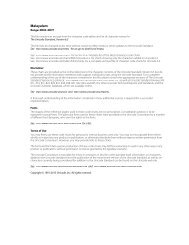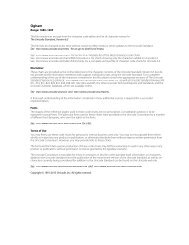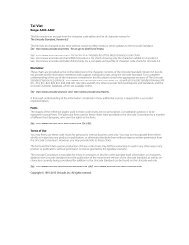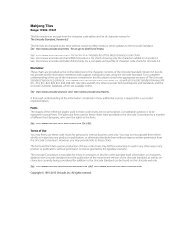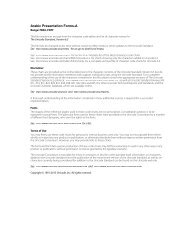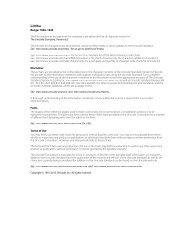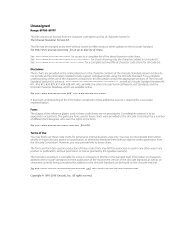Number of Viramas in closely related Malayalam and Grantha scripts
Number of Viramas in closely related Malayalam and Grantha scripts
Number of Viramas in closely related Malayalam and Grantha scripts
You also want an ePaper? Increase the reach of your titles
YUMPU automatically turns print PDFs into web optimized ePapers that Google loves.
Comment on L2/09-372<br />
(<strong>Number</strong> <strong>of</strong> <strong>Viramas</strong> <strong>in</strong> <strong>closely</strong> <strong>related</strong> <strong>Malayalam</strong> <strong>and</strong> <strong>Grantha</strong> <strong>scripts</strong>)<br />
Naga Ganesan (naa.ganesan@gmail.com)<br />
(a) I just went through the <strong>Grantha</strong> proposal by Mr. S. Sharma (L2/09-372).<br />
The ma<strong>in</strong> problem is that the close genetic relationship between <strong>Malayalam</strong> <strong>and</strong> <strong>Grantha</strong><br />
<strong>scripts</strong> is NOT acknowledged <strong>in</strong> Sharma’s proposal.<br />
Isaac Taylor (1829-1901), The alphabet: an account <strong>of</strong> the orig<strong>in</strong> <strong>and</strong> development<br />
<strong>of</strong> letters. Vol. 2, page 356,<br />
"From this lapidary alphabet two <strong>scripts</strong> were developed, a cursive <strong>and</strong> literary script.<br />
The first is represented by the Tamil, while the other has developed <strong>in</strong>to the <strong>Grantha</strong> or<br />
'book' alphabet used by the Tamil Brahmans for the Sanskrit transcriptions <strong>of</strong> their sacred<br />
books. From it [i.e., <strong>Grantha</strong> script] are derived two vernacular alphabets which are<br />
used on the Malabar coast; one is the Tulu <strong>Grantha</strong> (l<strong>in</strong>e 23), <strong>and</strong> the other the<br />
<strong>Malayalam</strong>, from which several characters were borrowed by the Christians <strong>of</strong> St.<br />
Thomas <strong>in</strong> order to supplement the Syriac (Karshuni) alphabet which they obta<strong>in</strong>ed from<br />
the Nestorian missionaries (see vol. i., p. 293.)"<br />
Student's Brittanica India, 5 volumes, Editors: Dale Hoiberg <strong>and</strong> Indu Ramch<strong>and</strong>ani,<br />
(2000) pg. 349 has the entry on <strong>Malayalam</strong> language.<br />
Of particular <strong>in</strong>terest is the fact that <strong>Malayalam</strong> is also written us<strong>in</strong>g Tamil <strong>Grantha</strong><br />
script that <strong>in</strong>cludes all the 5 Dravidian letters - e, o, llla, nnna <strong>and</strong> rra.<br />
pg. 349, <strong>Malayalam</strong> language:<br />
"The earliest record <strong>of</strong> the language is an <strong>in</strong>scription dated to AD c. 830. An early<br />
extensive <strong>in</strong>flux <strong>of</strong> Sanskrit words <strong>in</strong>fluenced the <strong>Malayalam</strong> script (derived from the<br />
<strong>Grantha</strong> script, itself derived from Brahmi): it has letters to represent all the Sanskrit<br />
sounds, besides the Dravidian sounds. The language also uses a script called Kolezhuttu<br />
(Rod script), which is derived from the Tamil writ<strong>in</strong>g system. The Tamil <strong>Grantha</strong> script<br />
is used as well to represent all Dravidian letters."<br />
My <strong>Grantha</strong> proposal, L2/09-345, requests encod<strong>in</strong>g the Tamil <strong>Grantha</strong> script <strong>in</strong> the SMP<br />
<strong>of</strong> Unicode, that <strong>in</strong>cludes all the Dravidian letters. As they form conjunct clusters <strong>and</strong><br />
virama uses are very different from Tamil script, the 5 Dravidian letters have to be<br />
encoded <strong>in</strong> <strong>Grantha</strong> block <strong>in</strong> the SMP.<br />
(b) Dravidian letters <strong>in</strong> <strong>Grantha</strong> script - History<br />
Some social factors that Dravidian letters came to be written <strong>in</strong>side <strong>Grantha</strong> script are<br />
described by pr<strong>of</strong>. S. N. Sadasivan that may be <strong>of</strong> <strong>in</strong>terest.
Dr. S. N. Sadasivan, A social history <strong>of</strong> India, A. P. H. Publish<strong>in</strong>g Co., N. Delhi, 2002,<br />
pg. 604<br />
"<strong>Malayalam</strong> rose from the status <strong>of</strong> a dialect to an <strong>in</strong>dependent language <strong>in</strong> the 9th<br />
century. The first script <strong>of</strong> <strong>Malayalam</strong>, as a dialect, was Vattezuttu (circular or spherical<br />
writ<strong>in</strong>g) <strong>of</strong> Njanamonam which was the contribution <strong>of</strong> Buddhists. Between the 3rd<br />
century AD <strong>and</strong> the 9th century, Vattezuttu was the only alphabet <strong>and</strong> even <strong>in</strong> the early<br />
part <strong>of</strong> the 19th century, it was used for <strong>of</strong>ficial records. By the 15th century, another<br />
script came <strong>in</strong>to vogue, the Kolezuttu (long script) which however could not replace the<br />
Vattezuttu nor could it become popular. A third group <strong>of</strong> letters the <strong>Grantha</strong>-lipi (book<br />
script) was said to have been <strong>in</strong>troduced at the <strong>in</strong>stance <strong>of</strong> the Brahm<strong>in</strong>s because they<br />
wanted to dissociate from the Buddhist Vattezuttu <strong>and</strong> the later Kolezuttu obviously <strong>of</strong><br />
non-Brahm<strong>in</strong> orig<strong>in</strong>.<br />
However by the 16th century the non-Brahm<strong>in</strong>s, the Sudras <strong>and</strong> the Ezhavas <strong>in</strong> particular,<br />
avidly learned the <strong>Grantha</strong> lipi <strong>and</strong> used it for extensive writ<strong>in</strong>g. Modern <strong>Malayalam</strong><br />
script is the reformed <strong>Grantha</strong> letters popularized by Tunchat Ezhuttaccan."<br />
In old times, <strong>Grantha</strong> script was used extensively to write Tamil <strong>and</strong> other Dravidian<br />
texts not just <strong>in</strong> South India, but also <strong>in</strong> South East Asian countries as well.<br />
(c) There are only TWO viramas <strong>in</strong> <strong>Malayalam</strong> <strong>and</strong> <strong>Grantha</strong> <strong>scripts</strong><br />
S. Sharma proposes now 3 <strong>Viramas</strong> for <strong>Grantha</strong> script which are non-existent <strong>in</strong> the<br />
<strong>Grantha</strong> script. This fact is clear when we look at any book on <strong>Grantha</strong> script such as P.<br />
Visalakshy, R. Grunendahl, … There is absolutely NO need to encode a third virama<br />
called “touch<strong>in</strong>g” virama. It is simply a glyph variation as the market was very, very<br />
small one or two presses did not take care to produce viramas uniformly <strong>in</strong> early 20 th<br />
century. Based on this glyph variation, there is no need to assign a new virama <strong>in</strong><br />
literature on the <strong>Grantha</strong> script as “touch<strong>in</strong>g” virama.<br />
S<strong>in</strong>ce the <strong>closely</strong> <strong>related</strong> nature <strong>of</strong> <strong>Malayalam</strong> <strong>and</strong> <strong>Grantha</strong> <strong>scripts</strong> is<br />
NOT mentioned at all <strong>in</strong> L2/09-372, the importance <strong>of</strong> hav<strong>in</strong>g Chillu marker sign with<br />
properties to create “prepausal” consonants is not provided <strong>in</strong> L2/09-372. Chillu, which<br />
means (word-)unit, is "prepausal" consonant <strong>in</strong>dicat<strong>in</strong>g breaks <strong>in</strong> word-segments (with<strong>in</strong><br />
words, such as sam- <strong>and</strong> san-) <strong>and</strong> word-end<strong>in</strong>gs, are well-known features common to<br />
both <strong>Grantha</strong> <strong>and</strong> its relative, <strong>Malayalam</strong> <strong>scripts</strong>.<br />
My <strong>Grantha</strong> proposal (L2/09-345) only proposes two types <strong>of</strong> viramas<br />
(1) a regular virama as <strong>in</strong> all <strong>of</strong> India’s <strong>scripts</strong> <strong>and</strong> (2) Chillu marker sign to produce<br />
prepausal-chillu consonants <strong>in</strong> <strong>Grantha</strong> script. The Chillus <strong>in</strong> <strong>Grantha</strong> <strong>and</strong> <strong>Malayalam</strong><br />
<strong>scripts</strong> are parallel <strong>and</strong> mark segment or word boundaries. Often, <strong>in</strong> manu<strong>scripts</strong>, <strong>Grantha</strong><br />
texts run cont<strong>in</strong>uously without word breaks, <strong>and</strong> Chillus help <strong>in</strong> identify<strong>in</strong>g full words or<br />
the prefixes such as sam- or san- <strong>in</strong> words.
(d) Regular Virama <strong>and</strong> Chillu Virama – Semantic differences<br />
While check<strong>in</strong>g with several temple priests work<strong>in</strong>g with <strong>Grantha</strong> <strong>scripts</strong> at temples such<br />
as Pazhani <strong>and</strong> Eechanari H<strong>in</strong>du temples, they mentioned about the semantic difference<br />
when Chillu consonants are employed. In a regular cluster, such as those <strong>in</strong>volv<strong>in</strong>g k.ssa<br />
as <strong>in</strong> other Indian <strong>scripts</strong>, no need for chillus. But wherever segment-breaks are<br />
necessary, we need chillus. Of course, some founts did not have enough chillus <strong>in</strong> their<br />
repertoire, so sometimes they substitituted with explicit-virama forms. But scholars such<br />
as Sri. Kalyanasundara Gurukkal, Eachanari V<strong>in</strong>ayakar Temple, expla<strong>in</strong>ed the necessity<br />
<strong>and</strong> importance <strong>of</strong> <strong>Grantha</strong> chillus an their connection with <strong>Malayalam</strong> chillus. They said<br />
that <strong>Malayalam</strong> chillus are directly formed from the uses <strong>and</strong> contexts <strong>of</strong> <strong>Grantha</strong> chillu<br />
usage.<br />
Rachana team authors such as Chitraja Kumar have written many documents tell<strong>in</strong>g<br />
similar reasons such as Sharma’s that <strong>Malayalam</strong> Chillus are not semantically different<br />
<strong>and</strong> no need to encode Chillus atomically. Like <strong>Malayalam</strong> chillus, <strong>Grantha</strong> chillus need<br />
representation <strong>in</strong> pla<strong>in</strong>-text data, <strong>and</strong> a simple way to encode them is to use a Chillu<br />
Marker sign which will be easily underst<strong>and</strong>able <strong>and</strong> easy to implement <strong>in</strong> fonts. Many<br />
<strong>Grantha</strong> font makers will look <strong>in</strong>to <strong>Malayalam</strong> fonts <strong>and</strong> use different glyphs to make<br />
their <strong>Grantha</strong> font.<br />
(e) For subjo<strong>in</strong>ed Vocalic L <strong>and</strong> Vocalic LL vowel signs<br />
There are NO words <strong>in</strong> any Indian language to write Vocalic LL vowel sign,<br />
And Vocalic L is <strong>in</strong>deed very rare. For these two vowel signs (Vocalic L <strong>and</strong> Vocalic LL)<br />
regular code po<strong>in</strong>ts should be used <strong>in</strong>stead <strong>of</strong> dual encod<strong>in</strong>g the same vowel signs twice.<br />
If there is a need, we can use ZWJ <strong>in</strong> sequences such as < Consonant, ZWJ, Vocalic L<br />
Vowel Sign> to <strong>in</strong>dicate that the Vocalic L vowel sign is subjo<strong>in</strong>ed <strong>in</strong>stead <strong>of</strong> its usual<br />
placement to the right side. Whether on the right side or subjo<strong>in</strong>ed, Vocalic L does not<br />
vary <strong>in</strong> mean<strong>in</strong>g at all, <strong>and</strong> therefore no need to encode them twice <strong>in</strong> <strong>Grantha</strong> block.<br />
(f) Vedic Svara signs<br />
As per the <strong>in</strong>structions from UTC South Asia committee, I have removed all the Vedic<br />
Svara signs from my proposal. As they are secondary to ma<strong>in</strong> letters <strong>of</strong> the Script (e.g.,<br />
Chillus, Sanskrit <strong>and</strong> Dravidian letters), we can come to their encod<strong>in</strong>g after all the ma<strong>in</strong><br />
characters are decided <strong>in</strong> <strong>Grantha</strong> block. Complete disunification <strong>of</strong> <strong>Grantha</strong> from other<br />
<strong>scripts</strong> such as <strong>Malayalam</strong> or Tamil has been requested which <strong>in</strong>cludes d<strong>and</strong>a signs, <strong>and</strong><br />
digits. <strong>Grantha</strong> Om sign is also requested <strong>in</strong> L2/09-345.<br />
Naga Ganesan<br />
October 31, 2009


